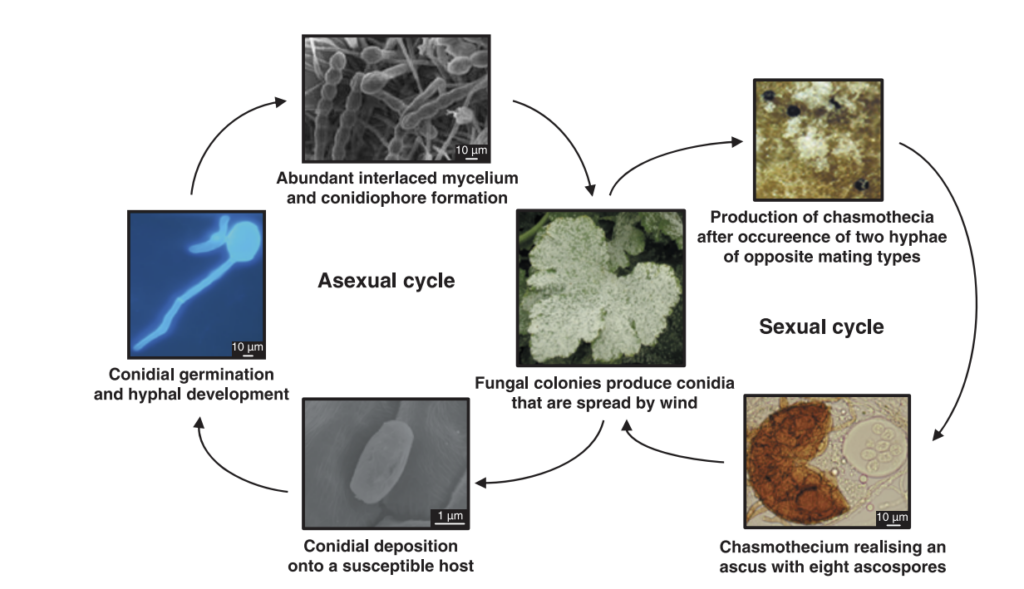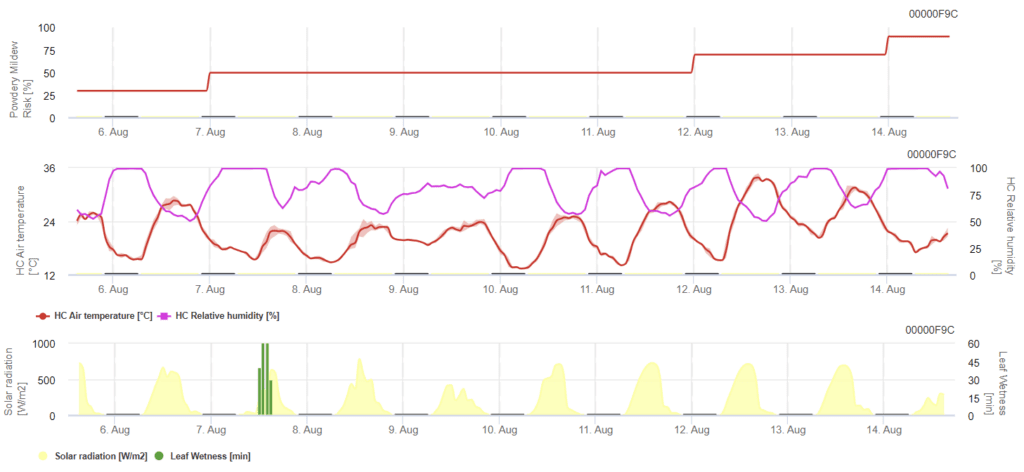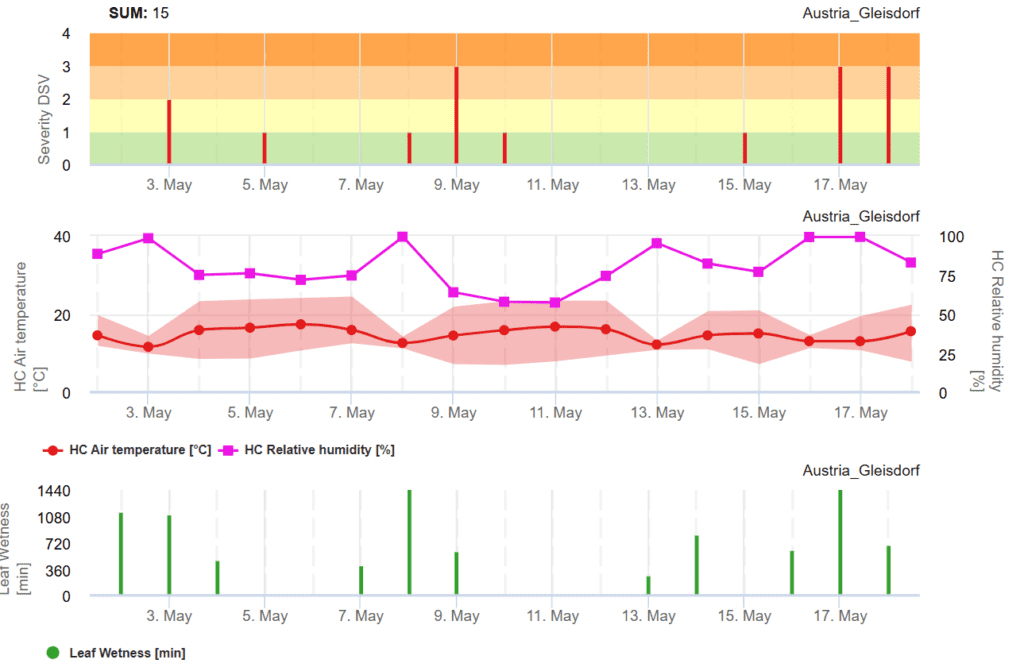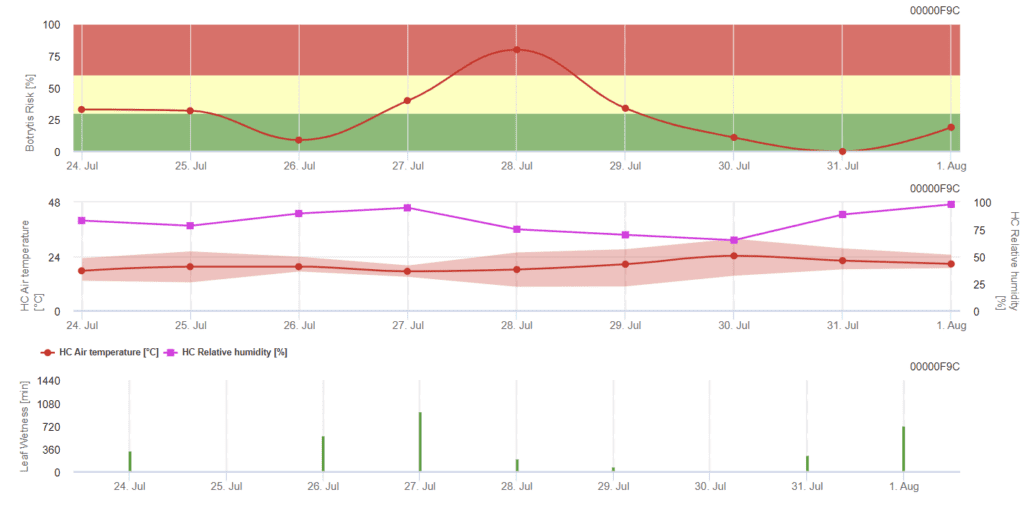
Cucumber, melon, pumpkin and zucchini disease models
Powdery mildew
Pathogen

Several fungi are responsible for powdery mildew in cucurbits, with Podosphaera xanthii and Erysiphe cichoracearum being the most significant pathogens. Historically, E. cichoracearum was regarded as the primary causal agent worldwide until 1958. However, P. xanthii has become the more prevalent species associated with cucurbit powdery mildew globally. E. cichoracearum typically thrives in cooler conditions, such as spring and early summer periods, while P. xanthii proliferates more effectively during the warmer months. Additionally, P. xanthii appears to be more aggressive than E. cichoracearum. Although distinguishing between the conidia of those two species can be challenging, the presence of fibrosin bodies in the conidia of P. xanthii serves as a key criterion in determining both.
Powdery mildew fungi reproduce through both asexual and sexual reproduction.
Asexually, conidia (asexual spores) land on a host plant, where they germinate and produce an appressorium and haustorium to extract nutrients from the plant. Conidiophores emerge from the hyphae and produce new conidia, dispersed by wind, spreading the infection. The incubation period usually lasts for 3~7 days and a significant number of conidia can be produced during a short time.
Sexual reproduction occurs when hyphae of opposite mating types meet and form cleistothecia. Cleistothecia contain several asci, each containing eight ascospores (sexual spores). They also serve as overwintering sources, enabling the pathogen to survive tough conditions. However, cleistothecia of P. xanthii has rarely been observed.
Symptoms

Although all cucurbits are susceptible, symptoms are less common in cucumbers and melons as many commercial cultivars have resistance. White powdery spots of mycelia and conidia are formed on leaf surfaces, petioles, and stems, making them easily recognizable. In the beginning, reddish-brown spots appear, turning white as hyphae and spores are produced later. These fungal colonies coalesce, covering the entire surface. Powdery mildew infection leads to reduced photosynthesis, premature senescence, and even plant death. While fruits are not directly or rarely attacked by the fungus, they may suffer deformation or early ripening. Such fruits exhibit poor storability (winter squash), low soluble solids with poor taste (melon), poor rind color (pumpkin), and shriveled, discolored handles (pumpkins). Disease stress can also cause imperfections on the fruit’s surface, including speckling, raised indentations, and edema.
FieldClimate Model
Melon/Cucumber/Zucchini/Pumpkin/Melon Powdery Mildew Risk

Infection can occur within a temperature range of 0°C to 32°C, with an optimal mean temperature between 20°C~27°C. Disease development is halted when daytime temperatures exceed 28°C. Favorable conditions for the pathogen include dense plant growth and low light intensity. High relative humidity also favors infection and conidial survival although infection can occur even as low as 50%. Rain and free moisture on plant surfaces are unfavorable for pathogen development. Therefore, dry conditions with limited leaf wetness are considered optimal for increasing the risk of powdery mildew outbreaks.
Literature
- McGrath, M. T. (1997). Powdery mildew of cucurbits. Nuñez-Palenius, H. G., Hopkins, D., & Cantliffe, D. J. (2006). Powdery mildew of cucurbits in Florida. HS-1067.(Viewed 18.12. 2019). Available: ef283dfcacb140070eb63b12bbbb8d9a9452.Pdf.
- PÉREZ‐GARCÍA, A. L. E. J. A. N. D. R. O., Romero, D., FERNÁNDEZ‐ORTUÑO, D. O. L. O. R. E. S., LÓPEZ‐RUIZ, F. R. A. N. C. I. S. C. O., De Vicente, A., & Tores, J. A. (2009). The powdery mildew fungus Podosphaera fusca (synonym Podosphaera xanthii), a constant threat to cucurbits. Molecular plant pathology, 10(2), 153-160.
Alternaria
Pathogen
Alternaria species, especially Alternaria cucumerina, cause leaf blight in cucurbits. The pathogen overwinters as mycelium in infected plant debris, surviving up to two years. Under favorable conditions—temperatures between 12°C and 30°C (54°F to 86°F) and high humidity—the mycelium produces conidia (spores) that disperse via wind, water splashes, equipment, or insects to new plants. Upon reaching susceptible hosts, the conidia germinate in the presence of moisture, usually with 8 to 24 hours of leaf wetness, and penetrate plant tissues through natural openings or wounds. The pathogen persists between growing seasons in infested debris, acting as the primary source of inoculum for future crops.
Symptoms
Alternaria infections on cucurbits manifest primarily on older leaves near the plant crown. Initial symptoms include small, circular, tan spots with white centers on the upper leaf surface. These spots enlarge, becoming light brown and forming slightly depressed lesions with concentric rings, characteristic of Alternaria infections. A yellow halo surrounds the lesions, which can eventually coalesce, leading to extensive necrosis and defoliation. In severe cases, this can result in reduced yield and premature fruit ripening. Fruit infections appear as sunken, brown lesions that may become dark and fuzzy due to spore production. Stem cankers may also form, appearing as water-soaked or discolored sections, potentially leading to stunting of the plant.
FieldClimate model

Sensors needed:
- Air temperature
- Leaf wetness
- Relative humidity
TomCast (TOMato disease foreCASTing) is a computer model based on field data that attempts to predict fungal disease development. The data over the last 24 hours may result in the formation of a “Disease Severity Value (DSV)”; essentially an increment of disease development. As DSV accumulate, disease pressure continues to build on the crop. When the number of accumulated DSV exceed the spray interval, a fungicide application is recommended to relieve the disease pressure. These Disease Severity Values are shown in the graph as well as the sum of these values. The spray interval range between 15 – 20 DSV and when the total number of accumulated DSV exceed these limit a fungicide spray is recommended.
Literature
- University of Massachusetts Amherst. (n.d.). Cucurbits: Alternaria leaf spot. Retrieved March 6, 2025, from https://ag.umass.edu/vegetable/fact-sheets/cucurbits-alternaria-leaf-spot
- University of Wisconsin-Madison. (n.d.). Cucurbit alternaria leaf blight. Retrieved March 6, 2025, from https://vegpath.plantpath.wisc.edu/diseases/cucurbit-alternaria-leaf-blight/
- University of Florida IFAS Extension. (n.d.). Alternaria leaf spot of cucurbits. Retrieved March 6, 2025, from https://plantpath.ifas.ufl.edu/u-scout/cucurbit/alternaria-leaf-spot.html
Late blight
Pathogen
Phytophthora spp., the primary pathogen causing Phytophthora blight in cucurbits, survives in soil for extended periods as oospores. Under warm, wet conditions, these oospores germinate to produce sporangia, which release motile zoospores that infect plant tissues. The pathogen can infect multiple times during a growing season, leading to rapid disease spread and significant crop loss. Infected plants often wilt and die within days, with roots and stems becoming soft and water-soaked. The pathogen can also infect weed roots, complicating crop rotation efforts.
Symptoms
Phytophthora blight affects cucurbits at all growth stages, leading to seedling damping-off, crown and vine rot, leaf spots, and fruit rot. Infected seedlings develop water-soaked lesions on the hypocotyl, causing rapid wilting and death. Mature plants may exhibit dark brown, water-soaked lesions on stems and vines, leading to sudden wilting and collapse. Leaves can develop dark, water-soaked spots that merge under moist conditions, resulting in extensive blight. Fruit infections start as water-soaked lesions, often on the underside, expanding and becoming covered with white mold, ultimately leading to fruit collapse. The disease spreads rapidly in warm, wet conditions, causing severe crop losses.
FieldClimate model

Sensors needed:
- Air temperature
- Leaf wetness
- Relative humidity
- Precipitation
The possibility for Late Blight to appear is predicted by accumulation of so-called “Severity values” from the NoBlight model. These values are based on weather conditions (mild and wet) and accumulate when they are appropriate for the development of the pathogen. We show these Severity values in combination with the recommended spray interval (reduced interval when severity is high and prolonged interval when severity is low).
Literature
- American Phytopathological Society (APS). (n.d.). Phytophthora blight of cucurbits. Retrieved March 6, 2025, from https://www.apsnet.org/edcenter/apsnetfeatures/Pages/PhytophthoraBlight.aspx
- Cornell University. (n.d.). Phytophthora blight of cucurbits. Retrieved March 6, 2025, from https://www.vegetables.cornell.edu/pest-management/disease-factsheets/phytophthora-blight-of-cucurbits/
Grey Mould
Pathogen
Grey mould in cucurbits, caused by Botrytis cinerea, leads to yield losses through fruit rot and plant death. The pathogen survives on plant debris in the soil as conidia, mycelia, or sclerotia, and under favourable conditions, spores germinate on senescent tissues or wounds. The fungus forms mycelium, which destroys cell walls and spreads, producing grey mould with conidiophores.
Infection can occur before or after harvest, with spores remaining dormant until storage, where high humidity and low temperatures trigger further growth. The fungus spreads from rotting fruit to healthy ones, spoiling entire crops. Improving ventilation through wide plant spacing and de-leafing helps reduce infection.
Symptoms
Botrytis cinerea affects all aerial parts of cucurbits, including leaves, stems, and especially fruits, forming characteristic grey mould.
On leaves, circular spots with concentric zones and a chlorotic halo appear, starting from the blade edges and progressing to necrosis. Wet cankers can also develop around stems, often from leaf stripping, picking wounds, or senescent tissue, leading to wilting and dieback.
Fruits, particularly those where dried petals remain attached, are vulnerable entry points for the fungus. It thrives in moist conditions and causes rot at the tips. Infected fruit shows typical soft rots, with water soaking and the rapid appearance of grey conidia masses. The fungus initially infects senescent flowers and spreads to adjacent fruit, causing blossom-end rot. Flower petals may show soft rotting or minute pockmarks, depending on environmental factors.
FieldClimate model
General Botrytis Cinerea Model

Sensors needed:
- Air temperature
- Leaf wetness
- Relative humidity
The model calculates the risk of grey mould. Warm periods with extended leaf wetness periods will increase the risk while dry periods reduce it.
Literature
- Messelink, G. J., Calvo, F. J., Marín, F., & Janssen, D. (2020). Cucurbits. Integrated Pest and Disease Management in Greenhouse Crops, 537-566. https://ephytia.inra.fr/en/C/8074/Zucchini-squash-Protection-methods
Recommended equipment
Check which sensor set is needed for monitoring this crop’s potential diseases.
